In June, Apple announced its first XR headset, the Vision Pro. As expected, the hardware blows away every other VR and AR headset on the market. Unfortunately, the advanced technology packed into the svelte and stylish Vision Pro headset drives the price out of reach of most consumers.
A new standard for XR headsets

For $3,499, the Apple Reality Pro sets a new standard for AR, VR, and the all-inclusive term XR. It allows you to place virtual screens around your Mac, take FaceTime calls without digging into your pocket, and write emails from your couch from a device Apple calls a “spatial computer.”
If tight Apple integration is all the Reality Pro provided, even early adopters might balk at the high cost. However, Apple did not disappoint, giving its XR headset truly revolutionary capabilities.
Intuitive control

Most VR headsets require controllers, but the Vision Pro allows full access with just your hands. Apple hasn’t shared all of the details, but it appears tapping and flicking your fingers, grabbing objects with your hands, and tracing with your index finger is enough to trigger actions and interact with visionOS.
Hand-tracking is well-supported by Meta’s Quest 2, Quest Pro and the upcoming Quest 3, but only in a few games and apps. Since Apple is making hands a primary input method, every app in the visionOS App Store should support hand interaction.
For authentication, the Vision Pro performs a retina scan to verify your identity quickly and effortlessly.
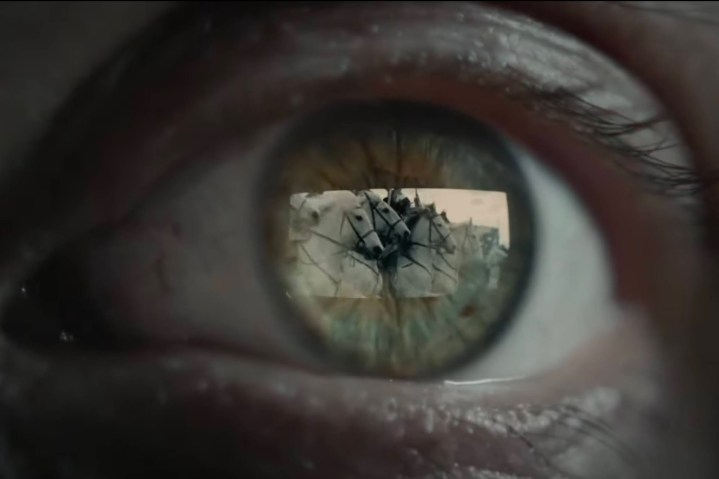
For gaming, you need more than hands. Thankfully, Apple realizes this and game controllers can be used for quick and responsive control.
Your private theater

Apple claims its headset provides a view that’s equivalent to a 100-foot wide screen. With the included Spatial Audio, this gives you a private theater for movies, TV shows, sporting events, and more. Of course, Apple TV+ will be available on the Vision Pro. Some rumors suggest Apple will event adjust the environment during movies in response to your emotions.
The image quality of Apple’s Vision Pro is also notably better than that of competitors, featuring 4K resolution for each eye packing a total of 23 million pixels into the two displays. That’s more than double that of Meta’s best VR headset and even eclipses the Varjo Aero’s impressive 2880-by-2720 pixel-per-eye resolution.
Apple didn’t share details about the display brightness or color space, but did mention brilliant color, spectacular detail, and high dynamic range. The presentation showed someone using the professional image editor Adobe Lightroom in Vision Pro.
The implication is that photographers, videographers, and graphic designers will be able use the Vision Pro instead of a monitor and still have confidence that picture quality will be good on traditional flat screens. The color fidelity is unconfirmed, for now.
Spatial recording
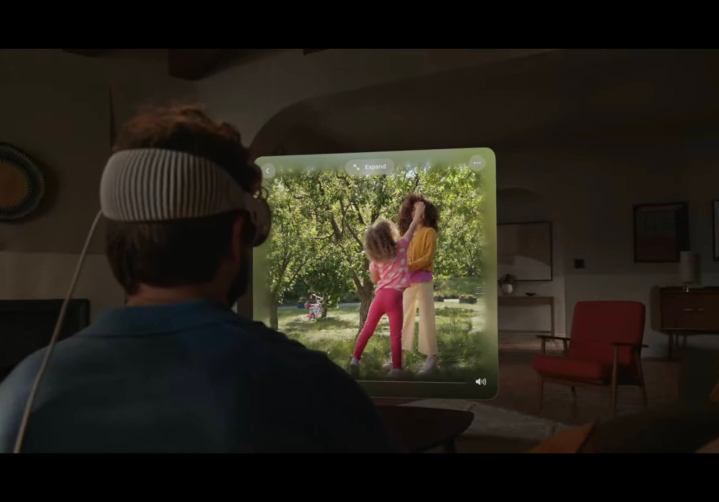
Apple makes some of the best mobile camera technology on the market and didn’t forget about photography and video with its do-everything headset. The Vision Pro can capture spatial photos and videos at the top of a button on the top of the headset.
These spatial memories can be played within the device to relive important moments with a realistic depth effect.
Vision Pro apps
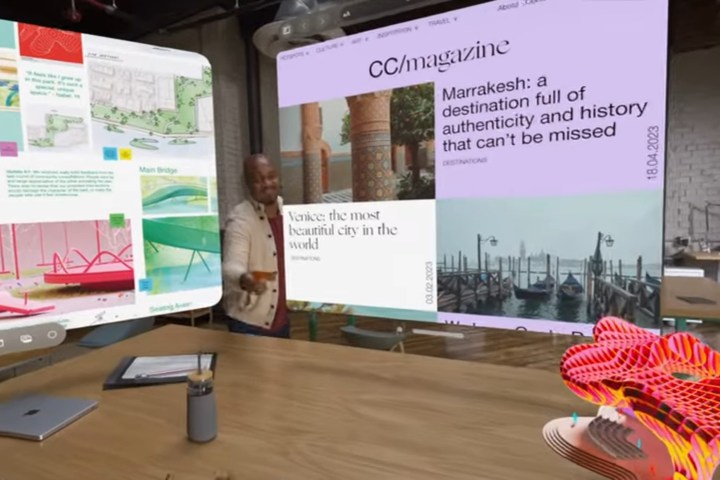
Apple’s Vision Pro has a home screen with apps, just like your iPhone. You can see the time and date, check the weather, and view notifications just as you can on any other Apple product.
Apple also brought many of its core apps to the Vision Pro, making it easy for its iPhone, iPad, and Mac customers to put on the headset and see familiar icons and themes. Safari, Photos, Music, Messages, and more are there. Transitioning to an entirely new way of interacting with a device isn’t easy, so this soft landing is important.
You can use voice input and a floating keyboard to enter text with only the Vision Pro or pair it with an Apple Magic Keyboard and Trackpad for more productivity.
That sounds like a great start. However, as an entirely new product category for Apple, the Vision Pro won’t have as rich a library of native third-party apps as a Mac or an iPhone. It’s been a focus for Apple to court developers, as you can read in our exclusive interview with Apple.
Meta’s Quest 2 and Pro headsets enjoy a vast library of games, and the platform has been around since 2019, picking up where the Oculus Rift left off.
This is where iPad and iPhone apps come in.
iPad Apps
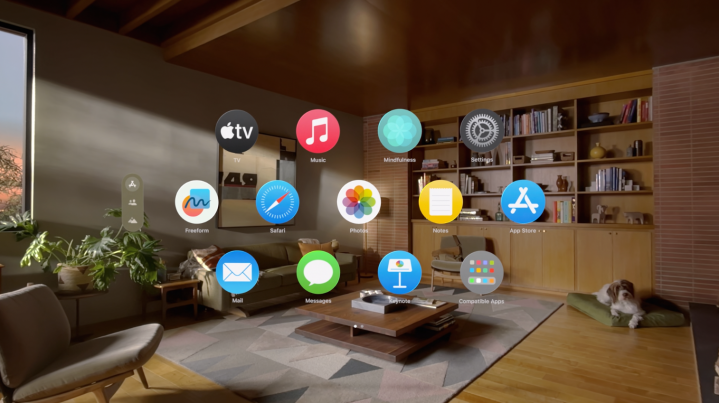
Apple has had key developers working on Vision Pro apps in advance of its announcement, but it will take years to develop new games and port existing content to the new platform. In the meantime, Apple is filling that gap with iPad apps, presumably including the recently released Final Cut Pro and Logic Pro.
The Apple Vision Pro will be able to run iPad apps, expanding its capabilities before immersive apps become available. Since the headset is powered by a high-performance M2 chip, it’s just as fast as an iPad Pro. The same chip powers the new 15-inch MacBook Air and other Macs.
When you put on an Apple Vision Pro, you can pick up where you left off with your iPhone, iPad, or Mac, multitasking with multiple apps side by side or focusing on just one app.
Mixed reality

Unlike the passthrough of the Meta Quest Pro and other VR headsets that have noticeable visual flaws, Apple’s mixed reality view of your actual surroundings seems nearly indistinguishable from what you’d see with the headset off. That’s thanks to higher-quality cameras and more processing power to align the generated images quickly and with great precision.
The Vision Pro’s digital crown, which looks like the one on the Apple Watch, allows for an easy transition between immersive view and seeing your room. When someone approaches you, the display will reveal them, and they can see you also.
Based on Apple’s Vision Pro demonstration, graphics processing has great enough performance to render objects that appear nearly as substantial as the physical desk or table you’re sitting at. This is the mixed reality we’ve all been waiting for. If only it didn’t cost more than a MacBook Pro.
Apple developed its ARKit framework six years ago, and the company says it was designed alongside the Vision Pro.
Gaming
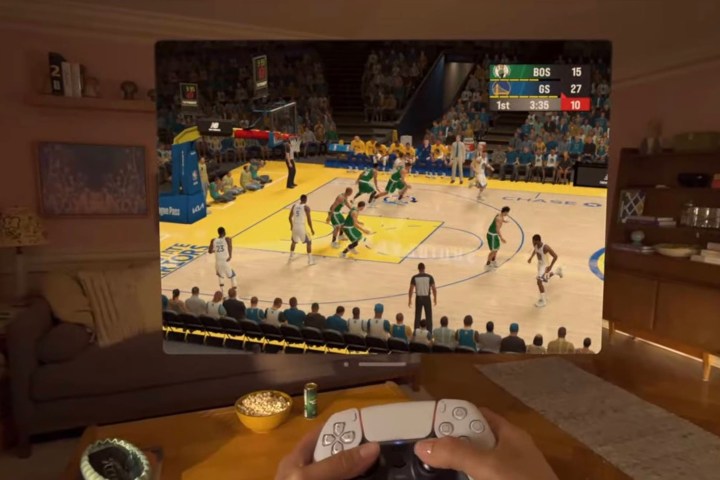
Apple’s Vision Pro uses Apple Metal 3 technology on an M2 chip, providing great performance for games. The challenge, of course, is getting enough content on the platform to compete with existing VR headsets with libraries that were built over several years.
Apple Arcade will provide over 100 apps at launch, drawing from the iPad library, but that won’t be enough to inspire gamers to buy Apple’s powerful, but gaming-constrained device.
Apple announced an intriguing partnership with Disney, but it is going to take time to meet the demand for gaming that takes advantage of the Vision Pro’s immersive capabilities, super-high resolution, and special features.
Eyes front and center
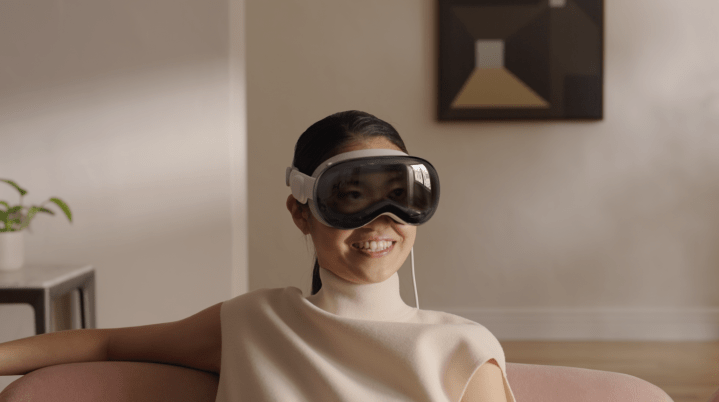
In what is certain to be the most controversial aspect of the Vision Pro headset, Apple placed a display on the outside of the headset so your eyes are still visible even when wearing the device. The view is a bit dark, but looks convincing.
We’ve previously seen Meta prototypes with a similar design called reverse passthrough. Apple’s implementation is much better, as if you’re wearing ski goggles. In addition, a recent patent suggests Apple’s lenses will be highly customizable for those with vision challenges.
Hardware
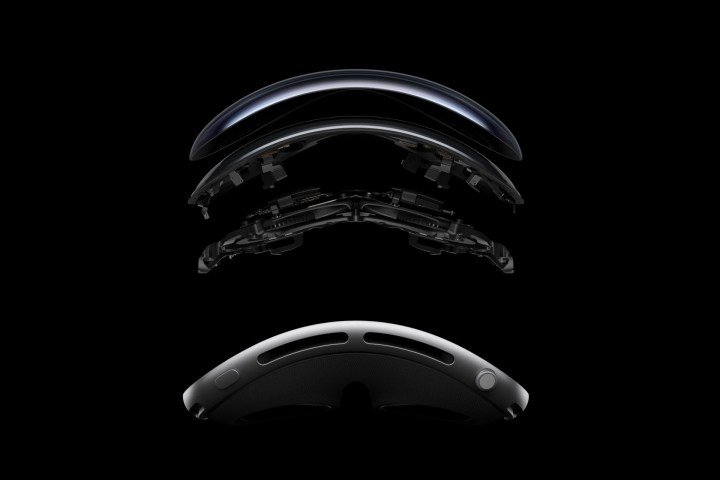
Apple packed the Vision Pro headset with cutting-edge technology. It’s clear that this had to be an expensive device. Earlier rumors suggested that the iPhone company realized this wasn’t a device for everyone. It’s meant for early adopters, developers, and corporations that can afford the cost given the potential it opens up.
With an M2 and a new R1 processor onboard, this will be a high-performance device with as much computing power as a MacBook Air. In the VR world, you’d need to connect to a PC with a powerful discrete GPU to match this speed.
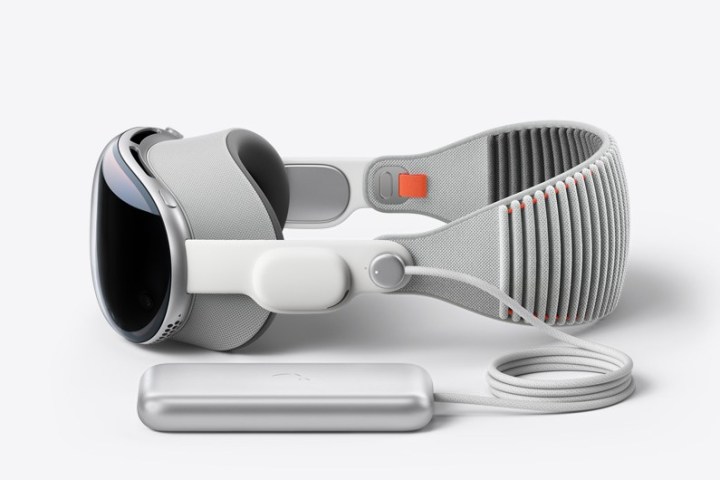
Apple didn’t delve into the battery life in its presentation, but quietly admitted that it’s only about 2 hours. An external battery pack is used so a cable connection is required to use the headset.
While most of us look on in envy, rest assured a lower cost Apple XR headset is already in development to bring Apple’s plan for an augmented reality future forward.
Price and availability
Apple announced the Vision Pro today, starting at the eye-watering price of $3,499. The powerful, new XR headset will be available early next year. At its September iPhone 15 event, Apple confirmed it still planned on shipping the device in early 2024.
We’ll be closely watching new developments, so stay tuned for full specifications, additional app details, and much more.
Editors’ Recommendations
